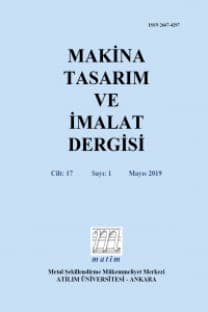Paletli Kara Platformları için Sıvama Yöntemi ile Üretilen Alüminyum Portör Tekerlerinin Dayanımı Üzerine bir Çalışma
Portör tekerleri kundağı motorlu obüsler ve tanklarda kullanılan palet ile araç arasında bulunan özel bir destek tekeridir. Bu çalışmada T-155 Fırtına Obüsünde kullanılan alüminyum alaşımlı malzeme ile flow forming yöntemi kullanılarak üretilen portör tekerinin üzerine etki eden minimum statik yük aracın toplam ağırlığından ve maksimum statik yük ise yapılan sayısal gerilme analizi hesaplamasından bulunmuştur. Bulunan gerilme değerleri kullanılarak özel üretim yöntemiyle imal edilmiş alüminyum portör tekerinin malzeme olarak nasıl bir yorulma karakteristiği göstereceği sayısal ve deneysel olarak test edilmiştir. Portör tekeri üzerinde tespit edilen bölgeden alınan ve ASTM standardına göre üretimi yapılan test numuneleri üzerinde deneysel yorulma testleri yapılmıştır. Yorulma testi yapılmış numunelerin içyapısı incelenerek, herhangi bir yorulma veya çatlak başlangıcı olup, olmadığı gözlemlenmiştir. Böylece flow forming ile alüminyum malzemeden imal edilmiş portör tekerinin gerilme ve yorulma analizleri ile gerçek zamanlı yorulma testi deneyi yapılarak nasıl bir yorulma karakteristiği göstereceği ortaya çıkartılmıştır. Bu çalışmada, katı model geometrisi ve seçilen alüminyum alaşım malzemesinin plastik deformasyon özelliklerine bağlı olarak nihai konfigürasyona ulaştırılan bir modelin maruz kalacağı yük aralığında yorulma dayanımının tayin edilmesi ve flow forming yöntemi ile alüminyum alaşımından yapılmış portör tekerleklerinin aynı yük koşullarında daha hafif ve yorulma direncine sahip aday portör tekerlekleri olduğunu gösterilmesi amaçlanmıştır.
Anahtar Kelimeler:
ovalama yöntemi, , portor tekeri, , paletli araçlar, gerilme analizi, yorulma dayanımı
A Study on Endurance of Aluminum Road Wheels Produced by Flow Forming for Tracked Land Platforms
Conventional road wheels made by steel material for defense vehicles are generally easy and cheap in production, but it brings extra, undesirable weight to the platforms. It is found that the use of aluminum for road wheels provides weight gain on tracked land platforms. Generally, common manufacturing techniques for road wheels are casting and forging. Since load spectrum that each tracked vehicle road wheel experiences is considerably high and dynamic, casting may not be a good solution for manufacturing due to lower load absorbing capability of casting products. On the other hand, forging might be a suitable method for dynamically loaded road wheels but, it is also expensive as well due to mold and final machining cost. In this study, aluminum alloy material (2014-T6) produced by flow forming method as an alternative to steel is subjected to numerical and experimental stress and fatigue analysis for being used in road wheels of heavy tracked defense platforms. Flow forming method was utilized for effective, cheap and lighter production. Therefore, main focus was put to see the effect of flow forming method on fatigue behavior of aluminum made road wheels. It was concluded that flow forming production method of aluminum road wheel would be suitable method to provide required low cycle fatigue life with advantageous of cheapness and lightness.
Keywords:
Flow Forming, Road wheel, Endurance, Fatigue, Stress Analysis, FEA,
___
- 1. Das, S., “Design and weight optimization of aluminum alloy wheel”, International Journal of Scientific and Research Publications, 4(6): 1-12, (2014).
- 2. Nallusamy, S., Prabu, M., Balakannan, K. and Majumdar, G., “Analysis of static stress in an alloy wheel of the passenger car”, International Journal of Engineering Research in Africa, 16: 17-25, (2015).
- 3. AMC Pamphlet, Engineering Design Handbook, Automotive Series, Automotive Suspension, Headquarters, U.S. Army Materiel Command, Washington, D.C. , 10, (1967).
- 4. AMC Pamphlet, Engineering Design Handbook, Automotive Series, Automotive Assembly, Headquarters, U.S. Army Materiel Command, Washington, D.C., 11, (1965).
- 5. Rambabu, P., Eswara Prasad, P.N., Kutumbarao, V.V. and Wanhill R.J.H., “Aluminum Alloys for Aerospace Applications”, Aerospace Materials and Material Technologies, Indian Institute of Metals Series, 29-52, (2017).
- 6. Davis, J.R J. R Aluminum and Aluminum Alloys, Alloying, Understanding the Basics, ASM International, (1993). 7. Groche, P. and Fritsche, D., “Application and modelling of flow forming manufacturing processes for internally geared wheels”, International, Journal of Machine Tools and Manufacture, 46(11): 1261-1265 (2006).
- 8. Marini, D., Cunningham, D. and et al, “Flow forming: A review of research methodologies, prediction models and their applications”, International Journal of Mechanical Engineering and Technology, 7(5): 285 – 315, (2016).
- 9. Wang, L., Chen, Y., Wang, C. and Wang, Q., “Fatgue life analysis of aluminum wheels by simulation of rotary fatigue test”, Journal of Mechanical Engineering, 57(1): 31-39, (2011).
- 10. Mandage, A.P., Sharma, M.H. and et al, “Fatigue life estimation of an aluminum wheel rim using finite element analysis”, IJSART, 2(3): 30-33, (2016).
- 11. Wong, C.C., Dean, T.A. and Lin. J., “A review of spinning, shear forming and flow forming processes”, International Journal of Machine Tools & Manufacture, 43(14): 1419-1435, (2003).
- 12. Paul, D.A., Wang, D.Y., “Fatigue behavior of 2014-T6, 7075-T6 and 7079-T6 aluminum alloy regular hand forgings”, Wright Air Development Centre, WADC Technical Report (1960).
- 13. Merati, M.M., Hellier, A.K. and Zarrabi, K., ”On the mixed Mode II/III fatigue threshold behavior for aluminum alloys 2014‐T6 and 7075‐T6”, Fatigue & Fracture of Engineering Materials & Structures 35(1): 2-12, (2011).
- 14. John R. Rumble, ed., CRC Handbook of Chemistry and Physics, 103rd Edition, CRC Press/Taylor & Francis, Boca Raton, FL.
- ISSN: 1302-9487
- Başlangıç: 1986
- Yayıncı: Makina Tasarım ve İmalat Derneği
Sayıdaki Diğer Makaleler
Faruk ELALDI, Süleyman Alper KALE
Savunma Sanayiinde Katmanlı İmalat ile Tedarik Zinciri Yönetimi
Yeni Bir Hibrid Metasezgisel Algoritma İle Drone Kolunun Yapısal Optimizasyonu
Kelebek Vanaların Simülasyon Destekli Deney Tasarımı ve Prototip Üretimi
Tornalanmış yüzey imgeleri gri ton ortalama değerlerinin takım aşınması ile ilişkisinin incelenmesi
